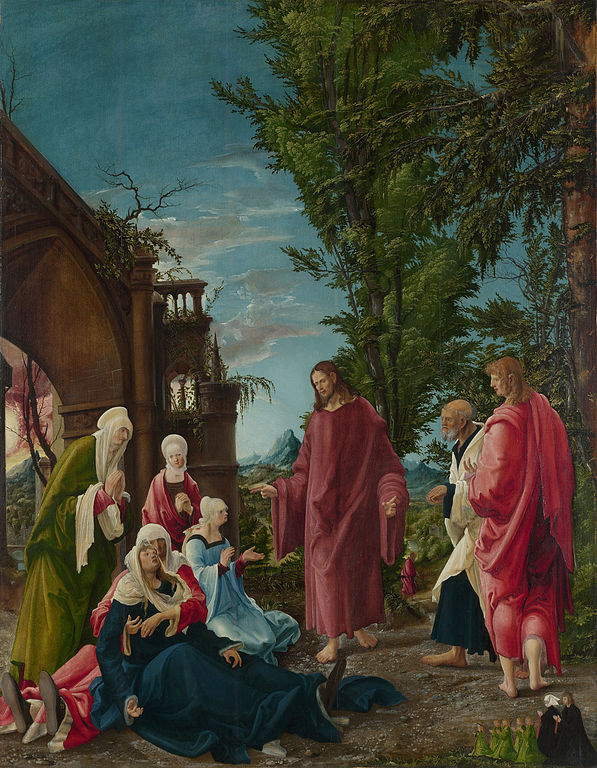National Gallery, London 19 February – 11 May 2014
'Beauty: a combination of qualities, such as shape, colour, or form, which please the aesthetic senses, especially the sight'
Oxford English Dictionary, 2013
What exactly makes a work of art beautiful? And how can this perception radically alter due to the changing world its viewer is living in? These are the intriguing questions being posed by 'Strange Beauty: Masters of the German Renaissance' at the National Gallery this spring.
This collection-focused exhibition takes a fresh look at paintings, drawings and prints by well-known artists such as Hans Holbein the Younger, Albrecht Dürer and Lucas Cranach the Elder – examining the striking changes in the ways these works were perceived in their time, in the recent past, and how they are viewed today.
More than 30 loans from UK collections will help visitors explore these fascinating themes. Key works coming to 'Strange Beauty' include the

Matthias Grünewald drawing of 'An Elderly Woman with Clasped Hands' (Ashmolean Museum, Oxford), (2nd from the left)

the renowned Holbein miniature of 'Anne of Cleves' (Victoria & Albert Museum, London),

'Portrait of Young Man with a Rosary' by Hans Baldung Grien (Royal Collection Trust on behalf of Her Majesty the Queen)
and a collection of fine drawings and prints by Holbein, Dürer and Altdorfer (British Museum, London).
The German Renaissance was part of the cultural and artistic awakening that spread across Northern Europe in the 15th and 16th centuries. German artists such as Dürer developed an international reputation, their fame reaching all parts of Europe, while renowned humanist scholars such as Erasmus of Rotterdam, the patron of Hans Holbein the Younger, played a leading role in reviving the study of classical texts in the service of Christianity.
Paintings such as

'The Ambassadors' by Holbein, '

Christ taking Leave of his Mother' by Albrecht Altdorfer,

'Cupid complaining to Venus' by Lucas Cranach the Elder,

'Portrait of a Man' by Hans Baldung Grien

and 'Saint Jerome' by Albrecht Dürer
were highly valued in the 16th century for qualities such as expression and inventiveness. However, by the 19th and early 20th centuries German Renaissance art was receiving a very mixed reception. Some viewers admired the artists' technical mastery and their embodiment of a perceived German national identity; others perceived these works of art as excessive or even ugly, particularly when compared to works of the Italian Renaissance.
Views such as these – alongside the shifting attitudes towards the German nation in the UK following the First and Second World Wars – were to have a direct effect on the formation and growth of the Gallery, and indeed all the UK national collections.
This was strongly evidenced in 1856 when the Trustees of the National Gallery sold the Krüger Collection – the only time in its entire history that the Gallery has had an Act of Parliament passed to de-accession and sell pictures. This group of 64 early Westphalian paintings from the 15th and 16th centuries was acquired for the Gallery by the then Chancellor of the Exchequer, William Gladstone, in 1854. However just three years later, 37 works were sold as they did not fit in with the 'present state of the Gallery' (as National Gallery Trustees Minutes noted at the time). Rarely publicly displayed contemporary documents from the National Gallery archive will be featured in the exhibition in order to illustrate this episode.
A highlight of the exhibition will be, for the first time ever, a reconstruction of the Liesborn altarpiece.
This work was created after 1465 and originally formed the high altarpiece in the Benedictine Abbey of Liesborn in Germany. In 1803, on the suppression of the monastery, it was dismembered, sold and scattered across the globe – eight pieces remain at the Gallery as part of the Krüger Collection. Now for the first time, visitors will be able to visualise the completed altarpiece as it might have looked during the 15th century.
The first room of 'Strange Beauty' introduces the types of paintings that were admired in 1824, when the Gallery was founded. Room 2 presents some of the German Renaissance painting acquisitions finally made by the National Gallery during the 19th and early 20th centuries – not all of which were immediately appreciated or admired. The third room focuses on the qualities of expressiveness and technical and stylistic invention which are so important within German Renaissance art. The masters of this genre, Holbein, Dürer and Cranach, will be exhibited in Room 4, highlighting their distinctive style. Past letters and documentation continue to reveal the historic reception to these paintings. Room 5 discusses themes of beauty and nature, examining the distinctive interpretation of these concepts by German Renaissance artists.
The final room of 'Strange Beauty: Masters of the German Renaissance' will be an interactive experience, inviting today’s visitors to comment, and vote, on their reactions to German painting.